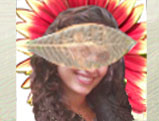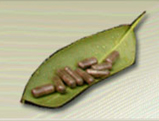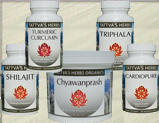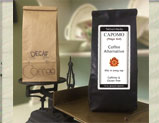 Loading... Please wait...
Loading... Please wait...Providing 25 Years Of Premium Service
Storewide Sale - Save 20%
Blog - panchakarma
An Introduction to Panchakarma
Posted by Dr. Vasant Lad , The Ayurvedic Institute , 1994 on 8th Dec 2009
Ayurveda emphasizes preventative and healing therapies along with various methods of purification and rejuvenation. Ayurveda is more than a mere healing system, it is a science and an art of appropriate living which helps to achieve longevity. It can guide every individual in the proper choice of diet, living habits and exercise to restore balance in the body, mind and consciousness, thus preventing disease from gaining a foothold in the system.
According to Ayurveda, every human being is a unique phenomenon (manifested through the five basic elements – ether, air, fire, water and earth) of cosmic consciousness. Vata (ether plus air), pitta (fire plus water) and kapha (water plus earth) are called the tridosha, meaning the three humors or the three organizations of the body, which are also derived from consciousness. Every individual psycho-somatic temperament or constitution is determined by these three doshas at the time of fertilization. When the embryo is formed the constitution is determined. There are seven basic constitutions according to Ayurveda: vata, pitta, kapha, vata-pitta, pitta-kapha, kapha-vata and vata-pitta-kapha. Every individual constitution has its own unique balance of V-P-K according to its own nature. The balance of V-P-K is the natural order, thus when this doshic balance is disturbed, it creates imbalance, which is disorder. Health is order; disease is disorder. Within the body there is a constant interaction between order and disorder, thus once one understands the nature and structure of disorder, one can re-establish order. Ayurveda believes that order lies within disorder.
Order is the state of health, as defined by Ayurveda, which exists when the digestive fire (agni) is in a balanced condition; the bodily humors (vata, pitta and kapha) are in equilibrium, the three waste products (urine, feces and sweat) are produced and eliminated normally, the seven bodily tissues (rasa, rakta, mamsa, meda, asthi, majja and shukra) are functioning normally, and the mind, senses and consciousness are working harmoniously together. When the balance of these systems is disturbed the disease (disorder) process begins.
The internal environment is governed by V-P-K, which is constantly reacting to the external environment. The wrong diet, habits, lifestyle, incompatible food combinations (e.g. milk and fish, melons and grain, yogurt and meat or cooked honey etc.), seasonal changes, repressed emotions and stress factors can all act either together or separately to change the balance of V-P-K. According to the nature of the cause, either vata, pitta or kapha undergo aggravation or derangement which affects the agni (gastric fire), and produces ama (toxins). This ama enters the blood stream and is circulated throughout the body, clogging the channels. Retention of toxins in the blood results in toxemia. This accumulated toxicity, once well established, will slowly affect prana (vital life energy), ojas (immunity), and tejas (cell metabolic energy) and result in disease. This can be nature’s effort at eliminating the toxicity from the body. Every so-called disease is a crisis of ama toxicity. Ama is the basic internal cause of all disease, due to the aggravated doshas.
Herein lies the key to the prevention of disease: help the body eliminate the toxins. To stop the further production of ama Ayurvedic literature suggests putting the person on a proper diet with appropriate lifestyle, habits and exercise, and administering a proper cleansing program such as panchakarma.
Although panchakarma is often thought of as the entire procedure, it really is only one part of a group of therapies belonging to a class of cleansing procedures called shodan. There is also a group of milder techniques called shaman for those not strong enough for shodan.
Purvakarma: Pre-purification Measures
Before the actual operation of purification begins, there is a need to prepare the body in prescribed methods to encourage the body to let go of the toxins. The two procedures are snehan and swedan. Snehan is the oil massage. Oil is applied to the entire body with a particular type of massage which helps the toxins to move towards the gastro-intestinal tract. Oil massage also makes the superficial and deep tissues soft and supple, thus helping to remove stress and to nourish the nervous system. Snehan is given daily for three to seven days, as indicated. Swedan is sudation or sweating and is given every day immediately following the snehan. An herbal concoction may be added to the steam to further loosen the toxins from the individual. Swedan liquifies the toxins and increases the movement of toxins into the gastro-intestinal tract. After three to seven days of snehan and swedan, the doshas become well “ripened.” A particular panchakarma method is then given according to the individual’s constitution and disorder, prakruti and vikruti, respectively.
Five Basic Shodhans: Cleansing Methods
1) Vaman: therapeutic vomiting or emesis
2) Virechan: purgation
3) Basti: enema
4) Nasya: elimination of toxins through the nose
5) Raktalmoksha: detoxification of the blood
Vaman: Emesis Therapy
Before vaman is administered, oil massage and fomentation are recommended on the night before the day of vaman. One to three days prior to vaman, the person should drink one cup of recommended oil two to three times a day until the stool becomes oily, or until he or she feels nauseated. The person should also eat a kaphagenic diet to aggravate kapha in the system. Vaman should be given early in the morning (kapha time). The person should eat basmati rice and yogurt with much salt early in the morning, which will further aggravate kapha in the stomach. The application of heat to the chest and back will liquify the kapha. The person should sit calmly on a knee-high chair and drink the concoction of licorice and honey, or salt water. This emesis preparation is measured and recorded before being drunk, so that at a later time the amount of vomitus from the decoction can be determined. After drinking the decoction the person should feel nauseated. He should then rub the tongue to induce vomiting, continuing until bile comes out in the vomitus. The degree of success in this treatment is determined by: 1) the number of vomitings (8 is maximum, 6 medium, 4 minimum), and 2) the quantity of vomitus (1 quart maximum, 1 1/2 pints medium, 1 pint minimum).
Emetic Substances: madan-emetic nut, madhuka-yastimadhu-licorice, neem-bitter leaf, bimbi, kutaj-kurchi- conessi bark, murva-clematis, triloba-devdaru-deodar, Cedrus deodara, Salt, NaCl, ela-cardamom, nux vomica.
After vaman, resting, fasting, smoking certain herbal cigarettes, and not suppressing natural urges (i.e. urination, defecation, gas, sneezing, coughing) is recommended. If vaman is administered properly, the person should feel relaxation in the lungs, will be able to breathe freely, will have lightness in the chest, clear thinking, clear voice, a good appetite, and all symptoms of congestion disappear.
After practicing vaman in the morning, the person should fast until 5 pm, then eat kitchari with ghee. He or she can drink cumin, coriander, ginger, fennel tea (equal portions). Steep in hot water and drink with one tsp. honey. Or he can drink honey lime tea, using one tsp. honey and one tsp. lime juice to one cup of hot water.
Indications for Vaman:
used for all kapha type disorders
good for pitta headache, dizziness, and nausea
will help to release blocked emotions
respiratory congestion
bronchitis
chronic cold
sinus congestion
kaphagenic asthma
Contra-Indications for Vaman:
below the age of 12 or over age 65
menstruation
pre-menstrual period (one week prior)
pregnancy
emaciation
delicate or sensitive person with too much fear, grief or anxiety
hypoglycemia
vata prakruti
vata diseases
heart diseases
during vata season
acute fever
diarrhea
obesity
Virechan: Purgation Therapy
When excess bile, pitta, is secreted and accumulated in the gall bladder, liver and small intestine, it tends to result in rashes, skin inflammation, acne, chronic attacks of fever, biliary vomiting, nausea and jaundice. Ayurvedic literature suggests in these conditions the administration of therapeutic purgation or a therapeutic laxative. Virechan is facilitated with senna leaves, flax seeds, psyllium husks or triphala in a combination that is appropriate for the individual person.
Senna leaf tea is a mild laxative, but in people of vata constitution, this tea might create griping pain, since its action aggravates peristaltic movement in the large intestine.
An effective laxative for vata or pitta constitutions is a glass of hot milk to which two teaspoons of ghee have been added. This laxative, taken at bedtime will help to relieve the excess pitta causing the bile disturbance in the body. In fact, purgatives can completely cure the problem of excess pitta.
When purgatives are used, it is important to check the diet. The patient should not eat foods that will aggravate the predominant humor or cause the three humors to become unbalanced.
Virechan Substances: Senna, prune, bran, flaxseed husk, dandelion root, psyllium seed, cow’s milk, salt, castor oil, raisins, mango juice, triphala.
Indications for Virechan:
allergic rash
skin inflammation
acne, dermatitis, eczema
chronic fever
ascites
biliary vomiting
jaundice
urinary disorder
enlargement of the spleen
internal worms
burning sensation in the eyes
inflammation of the eyes
conjunctivitis
gout
Contra-Indications for Virechan:
low agni
acute fever
diarrhea
severe constipation
bleeding from rectum or lung cavities
foreign body in the stomach
after enema
emaciation or weakness
prolapsed rectum
alcoholism
dehydration
childhood
old age
ulcerative colitis
Basti: Enema Therapy
Vata’s predominant site is the colon. Ayurvedic basti involves the introduction into the rectum of herbal concoctions of sesame oil, and certain herbal preparations in a liquid medium. Basti, is the most effective treatment of vata disorders, although many enemas over a prescribed period of time are usually required. It relieves constipation, distention, chronic fever, cold, sexual disorders, kidney stones, heart pain, backache, sciatica and other pains in the joints. Many other vata disorders such as arthritis, rheumatism, gout, muscle spasms and headaches may also be treated with basti.
Vata is a very active principle in pathogenesis. If we can control vata through the use of basti, we have gone a long way in going to the root cause of the vast majority of diseases.
Vata is the main etiological factor in the manifestation of diseases. It is the motive force behind the elimination and retention of feces, urine, bile and other excreta. Vata is mainly located in the large intestine, but bone tissue (asthi dhatu) is also a site for vata. Hence the medication administered rectally effects asthi dhatu. The mucus membrane of the colon is related to the outer covering of the bones (periosteum), which nourishes the bones. Therefore, any medication given rectally goes into the deeper tissues, like bones, and corrects vata disorders.
There are eight main types of basti, according to traditional texts, each with their own indications and contra-indications as listed below.
1. Anuvasana (oil enema) is used in pure vata disorders and when a person is having excess hunger or dryness related to vata imbalances.
2. Niruha-Asthapana (decoction enema) is used, among other conditions, for evacuation of vata, nervous diseases, gastro-intestinal vata conditions, gout, certain fever conditions, unconsciousness, certain urinary conditions, appetite, pain, hyperacidity and heart diseases.
3. Uttara Basti (through the urethra with men or vagina with women) is used for selected semen and ovulation disorders and for some problems involving painful urination or bladder infections. This is not to be used for someone with diabetes.
4. Matra Basti (daily oil enema) is used by someone emaciated by overwork or too much exercise, too much heavy lifting, walking too long of a distance, too much sexual activity or someone with chronic vata disorders. It does not need to be accompanied by any strict dietary restriction or daily routine and can be administered, in the appropriate cases, in all seasons. It gives strength, promotes weight and helps elimination of waste products.
5. Karma Basti (schedule of 30 bastis),
6. Kala Basti (schedule of 15 bastis; 10 oil + 5 decoction)
7. Yoga Basti (schedule of 8 bastis; 5 oil + 3 decoction).
In karma, kala and yoga bastis, it is better to give both types of basti in combination and not the oil and decoction separately. The conditions under which these are recommended are too detailed to be able to list in this article. In general, the indications and contra-indications that apply to basti also apply here.
8. Bruhana Basti (nutritional enema) is used for providing deep nutrition in select conditions. Traditionally, highly nutritive substances have been used, such as warm milk, meat broth, bone marrow soup and herbs like shatavari or ashwagandha.
General Indications for Basti:
constipation
low back ache
gout
rheumatism
sciatica
arthritis
nervous disorders
vata headache
emaciation
muscular atrophy
General Contra-Indications for Basti (include but are not limited to the following):
Enema therapy should not be used if the patient is suffering from diarrhea, bleeding of the rectum, chronic indigestion, breathlessness, diabetes, fever, emaciation, severe anaemia, pulmonary tuberculosis, old age or for children below the age of seven years.
Prana, life force as nerve energy, enters the body through the breath taken in through the nose. Prana is in the brain and maintains sensory and motor functions. Prana also governs mental activities, memory, concentration and intellectual activities. Deranged prana creates defective functioning of all these activities and produces headaches, convulsions, loss of memory and reduced sensory perception. Thus nasal administration, nasya is indicated for prana disorders, sinus congestion, migraine headaches, convulsions and certain eye and ear problems.
Breathing also can be improved through nasal massage. For this treatment, the little finger is dipped into ghee and inserted into the nose. The inner walls of the nose are slowly massaged, going as deeply as possible. This treatment will help to open the emotions. (Nose tissue is tender and for this application the fingernail must be kept short to avoid injuring the delicate mucus membranes.) Since most people have deviated nasal septums, one side of the nose will be easier to penetrate and massage than the other. The finger should not be inserted forcibly. The massage should proceed by slow penetration, the finger moving first in a clockwise, then counter-clockwise direction. By this means, the emotions that are blocked in the respiratory tract will be released. One may use this treatment each morning and evening. In this way breathing patterns will change as the emotions are released and the eyesight also will improve.
There are six main types of nasya, as listed below.
1. Pradhamana (virechan) Nasya (cleansing nasya) uses dry powders (rather than oils) that are blown into the nose with a tube. Pradhamana nasya is mainly used for kapha types of diseases involving headaches, heaviness in the head, cold, nasal congestion, sticky eyes, hoarseness of voice due to sticky kapha, sinusitis, cervical lymph adenitis, tumors, worms, some skin diseases, epilepsy, drowsiness, Parkinsonism, inflammation of the nasal mucosa, attachment, greed and lust. Traditionally, powders such as brahmi are used.
2. Bruhana Nasya (nutrition nasya) uses ghee, oils, salt, shatavari ghee, ashwagandha ghee and medicated milk and is used mainly for vata disorders. It is said to benefit conditions resulting from vata imbalances such as vata-type headaches, migraine headache, dryness of voice, dry nose, nervousness, anxiety, fear, dizziness, emptiness, negativity, heaviness of eyelids, bursitis, stiffness in the neck, dry sinuses and loss of sense of smell.
3. Shaman Nasya (sedative nasya) is used according to which dosha is aggravated but mainly for pitta-type disorders such as thinning of hair, conjunctivitis and ringing in the ears. Generally certain herbal medicated decoctions, teas and medicated oils are used.
4. Navana Nasya (decoction nasya) is used in vata-pitta or kapha-pitta disorders and is made from decoctions and oils together.
5. Marshya Nasya (ghee or oil nasya)
6. Prati Marshya (daily oil nasya) is performed by dipping the clean little finger in the ghee or oil and inserting into each nostril, lubricating the nasal passage with gentle massage as described above. This helps to open deep tissues and can be done every day and at any time to release stress.
Substances Used in Nasya: brahmi, ginger, ghee oils, decoctions, onion, garlic, Piper longum, black pepper, curry pepper, rose, jasmine, mogra flowers and henna.
Indications for Nasya:
stress
emotional imbalances
stiffness in the neck & shoulders
dryness of the nose
sinus congestion
hoarseness
migraine headache
convulsions
Contra-Indications for Nasya:
sinus infections
pregnancy
menstruation
after sex, bathing, eating or drinking of alcohol
should not be used below 7 years or over 80 years of age
Raktamoksha: Traditional Ayurvedic Method for Purification and Cleansing of the Blood
Toxins present in the gastro-intestinal tract are absorbed into the blood and circulated throughout the body. This condition is called toxemia, which is the basic cause of repeated infections, hypertension and certain other circulatory conditions. This includes repeated attacks of skin disorders such as urticaria, rashes, herpes, eczema, acne, scabies, leukoderma, chronic itching or hives. In such conditions, along with internal medication, elimination of the toxins and purification of the blood is necessary. Raktamoksha is also indicated for cases of enlarged liver, spleen and gout.
Pitta is produced from the disintegrated red blood cells in the liver. So pitta and blood have a very close relationship. An increase in pitta may go into the blood causing toxicity, and thus many pittagenic disorders.
Extracting a small amount of blood from a vein relieves the tension created by the pittagenic toxins in the blood. Bloodletting also stimulates the spleen to produce antitoxic substances which helps to stimulate the immune system. Toxins are neutralized enabling radical cures in many blood born disorders.
Bloodletting is contraindicated in cases of anaemia, edema, extreme weakness, diabetes and in children and elderly persons. It is also an illegal procedure within the United States.
Certain substances such as sugar, salt, yogurt, sour tasting foods and alcohol are toxic to the blood. In certain blood disorders these substances should be avoided to keep the blood pure. Burdock root tea, sandalwood, saffron, manjista, guduchi, rose and lotus are herbs that help to purify the blood. Turmeric, goldenseal, pomegranate juice, neem, oranges, beets and raisins can also be beneficial for blood disorders.
For raktamoksha treatment other than blood-letting, there are blood-purifying practices involving herbs, gem therapy or color water therapy.
For blood purifying therapy look for substances that are bitter and astringent and have blood thinning properties. Burdock root tea is the best blood purifier. For blood carried disorders such as allergy, rash or acne the patient should take a milk laxative and the next evening begin burdock root tea therapy. The tea is made from one teaspoon of powder in one cup of hot water. If taken every night, the action of the herb will begin to purify the blood.
Beneficial gems and crystals are pearl, coral, amethyst, rose quartz and jade.
In the practice of colored water therapy, red should be used in vata disorders, blue for pitta and purple for kapha.
For any raktamoksha treatment or related alternative treatment it is beneficial to refrain from yogurt, salt, sugar, alcohol, marijuana, sour and fermented foods.
Indications for Raktamoksha:
urticaria
rash
acne
eczema
scabies
leukoderma
chronic itching
hives
enlarged liver or spleen
gout
Contra-Indications for Raktamoksha:
anemia
edema
weakness
young children
old age
during pregnancy
during menstruation
During any step of panchakarma therapy traditional Ayurveda recommends certain lifestyle and diet guidelines.
It is advised to get plenty of rest during the panchakarma experience and to avoid strenuous exercise, sexual activity, late nights, loud music, television and other such stimulating experiences. It is also advised to take particular care to keep warm and away from the wind and to observe one’s thoughts and experiences during this time.
A mono-diet of kitchari and ghee is recommended, as well as essential restrictions on cold drinks, cold food, caffeine, white sugar, recreational drugs or alcohol and dairy products–all substances which should not be resumed (if at all) until some time after panchakarma is completed. The reason for this diet is that during the cleansing process the digestive fire (agni) takes a rest. Also, as toxins move back into the gastrointestinal tract the power of digestion is further slowed. Kitchari will provide adequate nourishment, nourishes all the tissues of the body, is very easy to digest, is excellent for de-aging of cells and assists in the detoxification and cleansing process. Kitchari is a seasoned mixture of rice and mung dal, and is basic to the Ayurvedic way of life. Basmati rice and mung dal both have the qualities of being sweet and cooling with a sweet aftertaste. Together they create a balanced food, that is an excellent protein combination and is tridoshic.
Panchakarma is a very special Ayurvedic operation requiring proper guidance from a highly trained and skillful Ayurvedic practitioner. This should not be undertaken just from information in this article. One should consult with an Ayurvedic physician, not just someone with a modest amount of training. Panchakarma is done individually for each person with their specific constitution and specific disorder in mind, thus it requires close observation and supervision. It is also done to best advantage, although not always, at the junctional period between two seasons, thus helping a person to prepare their internal environment for the oncoming season.















